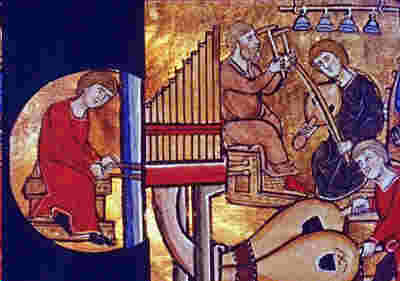
Welcome to music of the first world war Era—Page 4
About the music of the first world war era
It was the music of the first half of the
20th century:
It was the raucous stage and
vaudeville music in the US and in English music hall from the
first decade of the 19th century through the days when vaudeville died. It was the music of the English dancehall
up to the 30s and 40s.
It was the morale-building war songs of the Allies through war's end in
1918. It was the so-called
"war mongering" music in the US that lead up to moment when the
British luxury liner Lusitania was
torpedoed and the United States joined the fight alongside the British
Empire and the other allied nations.
It was the music of England's close-knit Russian ally, Czar Nicholas,
until his debacle on
the Eastern Front and after his country made a shameful peace with Germany. It was the music of the bleak days of the
Bolshevik Revolution, the violent and repressive Communist regime, of the Komintern and the Third International, the
Internationale, the Russian industrial revolution, and the
building of a mighty Soviet empire.
It was the music that once and for all put an end to the fin de siècle. It was the
music on the home front that bemoaned many a gruesome and gray day in the trenches. It
was the music of postwar relief, of grief, of the sudden realization that
it was over at last. It was the music of those who had had the good
luck to survive, of surprise at simply being free and alive.
It was the music of joie de
vivre and popping champagne corks and accordions playing in
Parisian streets, in the cafes and on the
boulevards and along the Champs Elysees during the gay days and the
wild, heady nights of celebration that
followed.
It was the
music of the Hun and the other Axis nations throughout the war and later,
in the drab cynicism, suffering, hunger, and dreary boredom that followed.
It was the music
of the Flapper, the taxi dancer, Prohibition, the Crash and Black Monday,
of boom and bust, of Paris in the Spring and the American presence there
in the 20s, 30s, and 40s, of the rise to power of the Nazis, their
subsequent remilitarization, and the
formation of the Great German War Machine out of the ashes.
- For more about artists and art in the vibrant Paris of the 20s and 30s,
visit the BBC Paris in the 20s arts page:
click here.
Roses of Picardy
This tune, which probably is the most beautiful, romantic, and poignant
love song to come out of WWI was written in England
in 1916. Oddly, Roses of Picardy, music by Hadyn Wood and lyrics by
Fred Weatherly, is a gentle melody born in a climate of violent, seething
warfare. Although the song makes no direct reference to combat, injury, or death, its audience could be counted on to understand this subtext.
- Hear a portion of Roses of Picardy recorded in 1919 by the
great Irish tenor John McCormack:
click here.
| Lyrics She is watching by the poplars,
Colinette with the sea blue eyes,
She is watching and longing and waiting,
Where the long white roadway lies.
And a song stirs in the silence,
As the wind in the boughs above,
She listens and starts and trembles,
'Tis the first little song of love....
Roses are shining in Picardy,
In the hush of the silvery dew.
Roses are flow'ring in Picardy,
But there's never a rose like you!
And the roses will die with the summertime,
And our roads may be far apart,
But there's one rose that dies not in Picardy!
'Tis the rose that I keep in my heart.
And the years fly on forever,
'Til shadows veil their skies,
But he loves to hold her little hands
And look into her sea blue eyes.
And she sees the road by the poplars,
Where they met in the bygone years,
For the first little song of the roses
Is the last little song she hears:
Roses are shining in Picardy,
In the hush of the silvery dew.
Roses are flow'ring in Picardy,
But there's never a rose like you!"
"And the roses will die with the summertime,
And our roads may be far apart,
But there's one rose that dies not in Picardy!
'Tis the rose that I keep in my heart. |
Picardy is a region on the English Channel in northern France bordering
on Belgium. Colinette is in a grove that looks out on the Channel. Is she
in England or in France? Part of the charm and mystery of the song is its
ambiguity. We can never be certain whether the song is what Colinette is
imagining or whether it is an artistic device that conveys to her what is
in the mind of her beloved. Is she thinking about him or he about her? is
the song sung by an omniscient third party describing both Colinette and
the soldier? Is it all these things?
For simplicity, we take the point of view taken by McCormack, who omits
stanzas five and six. We have omitted his rendition of stanzas one through
three.
An anonymous soldier there sings a tender ballad to his sweetheart back home during a
respite in the fighting. His is a
delicate protestation of his eternal and undying love.
In a verse (not heard), the soldier describes his loved one, whom he
knows is contemplating him in a grove across the channel, pining for him
and trembling for his safety. (Or is it a narrator who is speaking? Is she
in France? Is she English? Is she French?)
He expresses his peril in terms of the
mortality of flowering roses that shine in "the hush of the silver dew" on
the now-quiet battlefield. (Or does she imagine him to be the rose?)
The roses evoke images of other soldiers already
struck down on that field, soldiers whose lives were once as fragile and
evanescent as the roses he now sees, as fragile and evanescent as his own
life now. (Perhaps the flowering roses are nurtured by the spirits of the soldiers
who lie beneath them; perhaps they are those spirits.)
His sweetheart is also a rose, another kind of rose whose beauty
outshines the tangible ones he sees. Alas, the soldier bemoans, the roses
he observes will die with the summertime; all memory of these soldiers
will pass away. The paths he and his love travel are far apart. He may die
like the other soldiers while she goes on without him.
But there is another kind of rose
on this field, an abstract rose—the rose in his heart.
Unlike
the roses on the field and the dead soldiers they represent, his love—this
unseen rose in his heart—is not evanescent. The paths he and his
sweetheart travel may be far apart—he may die—but
the rose he holds in his heart and the rose
that is his sweetheart will go on living even if
the harsh reality of his death should overtake them. Their love will
endure even if he does not.
The sight of flowering silver roses bathed in bright morning sunlight and the
flowering of love in the soldier's heart together create a magic moment. That moment
is all the more powerful and mournful because it is understated. The rose in his heart
and the rose that is his sweetheart's beauty are two abstractions that stand in sharp contrast to the
roses on the battlefield. They uplift and sanctify the scene.
Note the absence of
a direct reference to the suffering and struggle that is presumed to have
occurred prior to this moment. The physical roses before him are softened
symbols of the fury, waste, futility, and finality of
war. Anything harsh in the song would disrupt the romantic tenderness
inherent in this expression of undying love; violent imagery would subvert
what is, in the final analysis, a triumphant assertion that love will
outlast war and death.
Christmas in the Trenches
After five months of fighting, the Christmas of 1914, the first of the
war, proved to be one of the most remarkable in the annals of warfare. Its
like may never be seen again.
Both sides agreed to take a holiday from warfare, a holiday which for
good reasons has come to be called the "Amazing Truce." During the truce,
which lasted only a day, thousands of German and British soldiers met on
the battlefield in no-man's land under a flag of truce. theyshook hands,
shared treats from home, showed each other pictures of family and
sweetheart, played ball games, played and sang carols together in memory
of their shared religion and common cultural heritage. For a moment they celebrated
their brotherhood and not their hatred.
- Feel the emotion of that miraculous occasion. Hear a portion of a modern recounting
the story of the Amazing Truce,
Christmas in the Trenches, written by J. McCutcheon and sung by John
McDermott:
click here.
Oh, How I Hate to Get Up in the Morning
During the war, Irving Berlin wrote a musical called Yip-Yip-Yaphank to raise
relief funds for the army, to sell War Bonds, and to bolster
American moral.
One of the unforgettable songs he wrote for this musical revue was Oh, How I Hate to Get Up in the Morning. This
piece of history was revived in WWII.
- Learn some of the story behind Yip-Yip-Yaphank and the WWII revival of
Berlin's WWI song, Oh, How I Hate to Get Up in the Morning; hear
selections from This Is the Army:
click here.
How 'Ya
Gonna Keep 'Em Down On the Farm After they've Seen Paree?
The war changed the world forever. Nowhere was that change felt more
keenly than in isolationist America, where farm boys and city
boys alike had been brought up to live simple, straightforward lives and
where all questions had black and white answers. Once they had faced death
and seen hell, the old ways had to change.
Now that doughboys were returning from war with a taste of Paris under
their belts, life could never be the same. After a leave in Paris, after
carousing with wine, women, and song, after a glimpse of how the "other
half" lives, after witnessing the trenches, how could they be expected to return to the outmoded ways, old fashioned ideas,
and pre-war conditions waiting for them back home?
A song called How 'Ya
Gonna Keep 'Em Down On the Farm After they've Seen Paree?, written by
Sam M. Lewis, Joe Young, and Walter Donaldson, asks these kinds of
questions. The performance we hear was recorded in 1919 by Arthur Fields.
- Hear Mother Reuben's short-sighted answer in How 'Ya Gonna Keep 'Em
Down On the Farm After they've Seen Paree?:
click here.
ETAF Recommends
...Coming.
—Page 1,
2,
3,
4,
5—
|
www.Electricka.com
This web site and
its contents are copyrighted by
Decision Consulting Incorporated (DCI).
All rights reserved.
You may reproduce this page for your personal
use or for non-commercial distribution. All copies must include this
copyright statement.
—Additional
copyright and trademark notices— |
|
| |
|
Exploring the Arts Foundation |
| |
 |
| |
|


